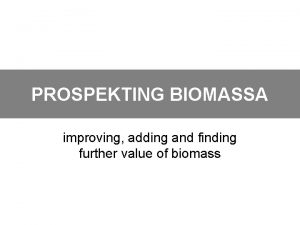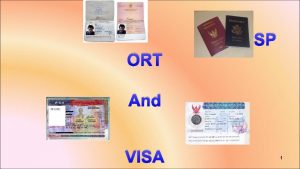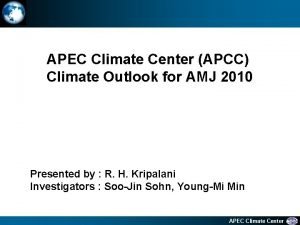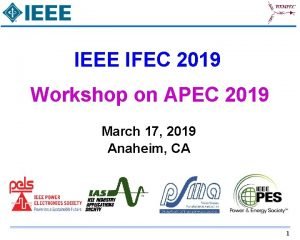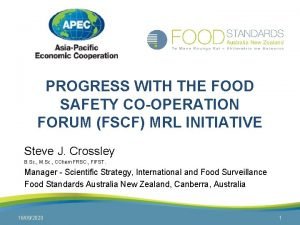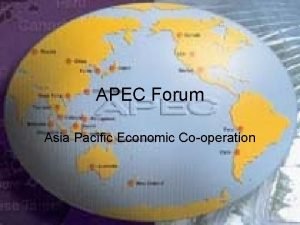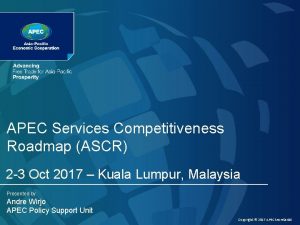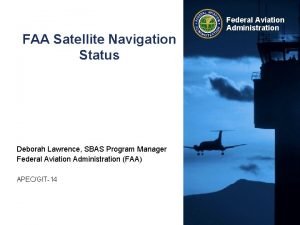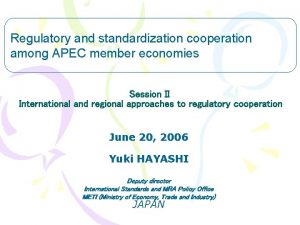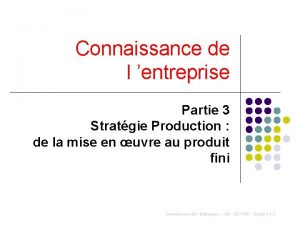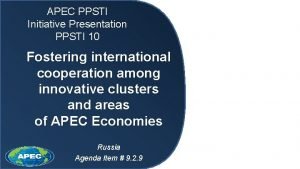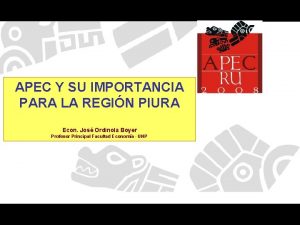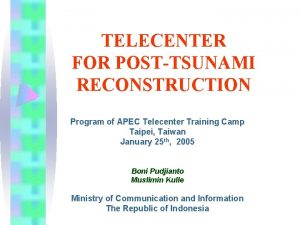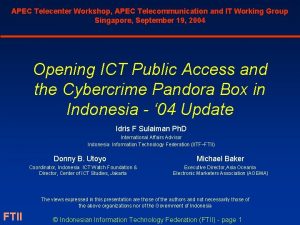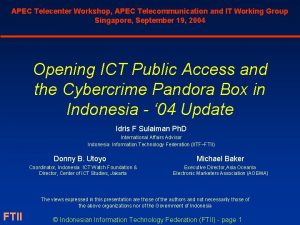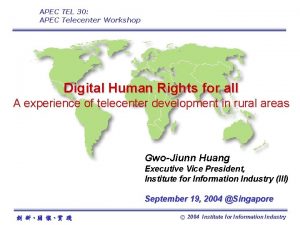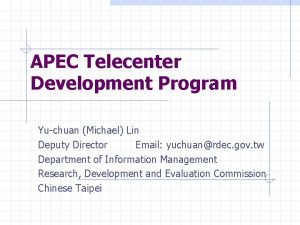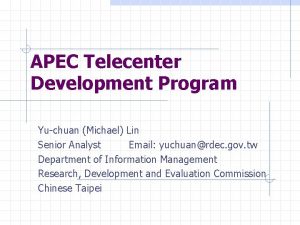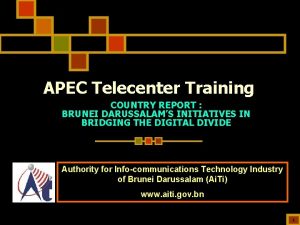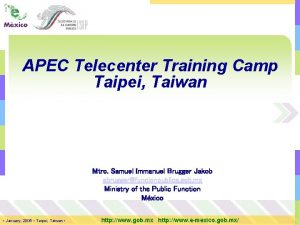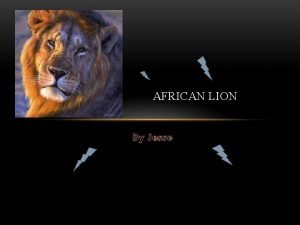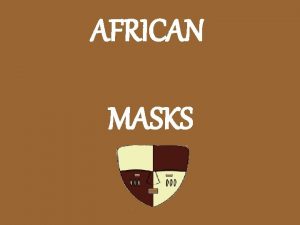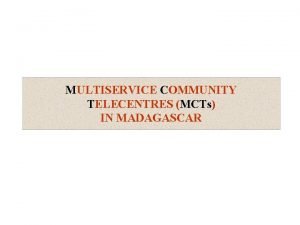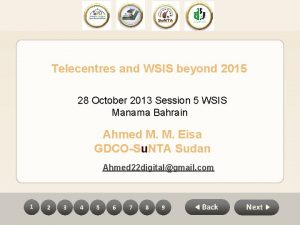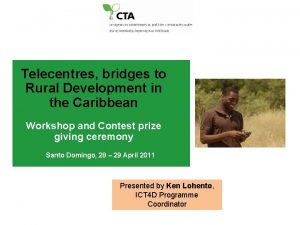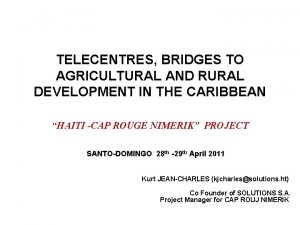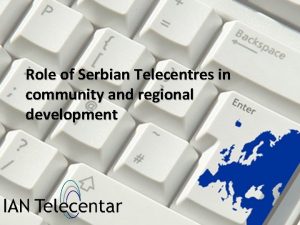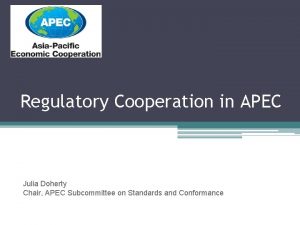Telecentres The African Experience APEC Telecenter Workshop APEC


































- Slides: 34

Telecentres: The African Experience APEC Telecenter Workshop APEC TEL 30 Sunday, September 19, 2004 Singapore Mike Jensen mikej@sn. apc. org

The Need for Public Access • Limited incomes • High infrastructure costs => Low diffusion of infrastructure and low levels of private ownership of facilities ==> Opportunities for public access: Payphones -> multi-purpose facilities • Multipurpose Telecentres exploit convergence in ICTs, making the investment in infrastructure more attractive because the telecom facility can deliver more services than voice calls

ICT Usage in Africa Of the 800 million people in Africa: 1 in 4 have radio (200 m) 1 in 13 have TV (50 m) 1 in 33 have fixed telephone line (24 m) 1 in 24 have GSM line (33 m) 1 in 130 have a PC (6 m) 1 in 130 use the Internet (6 m) 1 in 400 have pay-TV (2 m) But huge variations between countries means often misleading to generalise

Lack of Fixed Lines The Key Access Barrier - In 2003 there were about 24 million lines for the 800 million people in Africa (1 in 33). In Sub Sahara outside South Africa, there were only about 4 million lines (1 in 200) - In many countries more than 90% of these lines are in the capital city and secondary towns, while 70 -80% of the people live outside these areas: E. g. Malawi has 8 000 fixed lines for the 10 million rural populuation: 1 line for every 1250

Teledensity in Africa http: //www. idrc. ca/acacia Sources: ESRI, GSM Association/Coversoft , ITU, Mike Jensen

Local loop in Kenya and Nigeria

GSM Coverage

Two Telecentre Types ● ● Type-A: Demand-driven expansion of services at existing public telephoneshops and small businesses Type-B: Government programmes to support public access, esp in rural areas

Type-A - Demand Driven Telecentre examples Senegal • The PTO (Sonatel) does not provide public phones – 10 000+ public telephone shops run by local entrepreneurs licensed by the PTO – Many have added fax & word processing & Internet services, VOIP a significant driver – Sonatel gives 40% discount on tariffs and assists telecentres with new services by providing advice (no financing).

Phone Booths and Prepaid Phone Cards, Lilongwe

Malawi 850 Public Call Operators (PCOs)

Home-based PCO, Zomba

Phone Kiosks, South Africa

Private Multipurpose Telecentre, Mbeya, Tanzania

Hybrid Telecentre and Hair Salon South Africa

E-Touch C-Café Franchise, Nairobi Kenya

Type-B Telecentres: Government Programmes • Payphone & Telecentre Roll-out Programmes as part of Government policies to address Universal Access objectives and the digital divide • To improve access for students and teachers • Job creation and computer literacy training programmes

PTO Sponsored Fixed Wireless Phone Services in Rural South Africa

Phone Shops with Subsidised Calls by GSM Mobile Operators, South Africa

Government Supported Multipurpose Telecentres South Africa – – – Universal Service Agency established with the ‘ 96 Telecommunications Act Startup costs for the telecentres comes from the telecom operators who contribute 0. 2% of their profits to a Universal Service Fund Also supported by partnerships with development agencies, NGOs, private sector and government who 'adopted' individual telecentres Initially aimed to roll out 2000+ telecentres by now, only about 90 operational, 50% of these sustainable Government Communication Services (GCIS) launched its own container-based computer literacy/Internet access programme

Universal Service Agency Telecentre, South Africa

Government Telecentres Tunisia • Agence Tunisienne d’Internet (ATI) - the government authority for maintaining the Internet backbone in Tunisia, tenders for 100 s of telecentres, called Publi. Nets

What Model/Which Partners are Successful? Local small scale entrepreneur Franchise by large company/govt department Post Office School Community group Church group Co-operative (Agriculture) Library service Municipality Radio station

Technical Design - Depends on the scale of the telecentre Medium/Large telecentre – At least 10 phone lines, call management system, cell phones for rental, fax, scanner, 5 PCs including Internet access, printer, photocopier, digital camera, overhead projector, TV, VCR, cassette tape, catering. Mini telecenter - Cabinet with 1 PC, fax, 3 -in -1 scanner/printer/copier, call meter. Micro telecenter - pay phone with built-in web browser/smart card reader, receipt printer. Micro-mobile telecentre - wireless terminal or cell phone

Which Services? • Starting small: – Phones – Voice is still the killer application – Fax – Office apps & Internet access – Typing & small copy runs – IT & Internet Training • Expansion: – More lines, more PCs – Local email/printing/delivery – Additional office services - DTP/Scanning – Printing/reprographics – Photography (digital camera/CDROM) – Financial Services/E-Procurement – Meeting/training venue – Materials and ICT equipment sales – Connectivity to surrounding institutions

What connectivity? • Telecom Link – Normal phone lines - POTS/PSTN – Cellular phones – Wireless Local loop – Leased Line & DSL – VSAT – Wi. Fi – Point-to-Point • Access Network – 1 PC/Modem/shared email address – LAN/shared dialup modem/PPP link with multiple remote email/websites – Local mail server/video/audio on demand server – Voice mail, Internet telephony/fax server

Emerging Infrastructure Trends - Wireless Data - Wi. Fi/broadband, narrowband HF/UHF - User financed Infrastructure & Mesh Networks - Digital powerline - Low-cost equipment – Open Source Software, recycled PCs, thin clients, handhelds/PDAs - Mixed technologies/Hybrid systems – Internet supported Radio, TV, & Print, PSTN+ simplex satellite, - GSM/SMS <-> Email/Web - Mobile/Roving Telecentres

Other Infrastructure Issues - Voice Call revenue is key to financing infrastructure and services - All options need effective bandwidth management strategies – spam / virus cops, proxy/cache, firewalls and b/w monitoring - Regulatory restrictions limit use of independent connectivity - Access to skills for maintenance and installation difficult in rural areas

External systemic factors: Electricity Import duties Education

Alternate Power Sources Photovoltaic/Solar cells

Tanzania Biogas Manure from 12 cows generates methane, mixed with diesel in a 70: 30 ratio, used to drive generator produces 10 Kilowatts. Runs 15 -16 computers for eight hours daily

Reducing Power Consumption In next five years a high capacity desktop requiring low power should be available: The central processor - 0. 8 W Full sized OLED screen - 4 W Solid-state secondary storage - 0. 2 W RAM memory, graphics cards, and other on-board devices - 0. 4 W Wireless internet connection - 0. 1 W Total system power consumption will be on the order of 5 Watts - perhaps the equivalent of two cell phones today - and this will mostly be a function of screen size and display parameters Note that a comparable system today might require nearly 400 watts to power

Key Barriers Limited liberalisation ● Policy not keeping up with technology developments - few African countries allow Vo. IP, private VSAT and wireless data/Wi. Fi, high license fees for satellite terminals, where available - High import duties on comms equipment - Limited finance for small public access businesses and for consumers to obtain equipment - Limited skills and knowledge of options - Limited perfusion /unreliable electricity grid ●

Thank You mikej@sn. apc. org
 Experience expectant vs experience dependent
Experience expectant vs experience dependent Continuity vs discontinuity
Continuity vs discontinuity Direct experience and indirect experience
Direct experience and indirect experience Apec
Apec Guidebook on apec projects
Guidebook on apec projects Passp
Passp Apcc climate
Apcc climate Apec 2019
Apec 2019 Apec food safety cooperation forum
Apec food safety cooperation forum Asia pacific economic forum
Asia pacific economic forum Apec services competitiveness roadmap
Apec services competitiveness roadmap Apec
Apec Egs
Egs Mapa da apec
Mapa da apec Apec
Apec Apec
Apec Apec ppsti
Apec ppsti Apec 2006
Apec 2006 Các châu lục và đại dương trên thế giới
Các châu lục và đại dương trên thế giới Cách giải mật thư tọa độ
Cách giải mật thư tọa độ Bổ thể
Bổ thể Từ ngữ thể hiện lòng nhân hậu
Từ ngữ thể hiện lòng nhân hậu Tư thế ngồi viết
Tư thế ngồi viết Thế nào là giọng cùng tên?
Thế nào là giọng cùng tên? Thơ thất ngôn tứ tuyệt đường luật
Thơ thất ngôn tứ tuyệt đường luật Hát lên người ơi
Hát lên người ơi Khi nào hổ mẹ dạy hổ con săn mồi
Khi nào hổ mẹ dạy hổ con săn mồi Diễn thế sinh thái là
Diễn thế sinh thái là Vẽ hình chiếu vuông góc của vật thể sau
Vẽ hình chiếu vuông góc của vật thể sau Công thức tính thế năng
Công thức tính thế năng Phép trừ bù
Phép trừ bù Tỉ lệ cơ thể trẻ em
Tỉ lệ cơ thể trẻ em Thế nào là mạng điện lắp đặt kiểu nổi
Thế nào là mạng điện lắp đặt kiểu nổi Lời thề hippocrates
Lời thề hippocrates Vẽ hình chiếu đứng bằng cạnh của vật thể
Vẽ hình chiếu đứng bằng cạnh của vật thể



